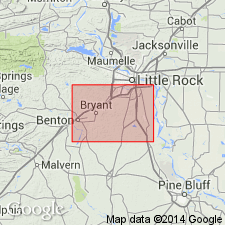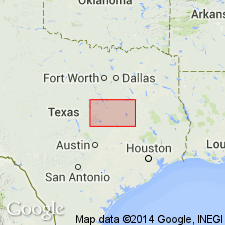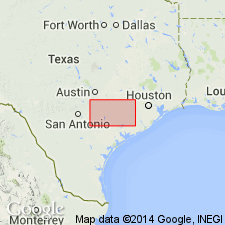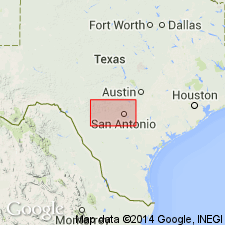
- Usage in publication:
-
- Pisgah limestone member
- Modifications:
-
- Original reference
- Dominant lithology:
-
- Clay
- Limestone
- AAPG geologic province:
-
- East Texas basin
Summary:
Pg. 530, 535, 536, 540, 550. Pisgah limestone member of Kincaid formation of Midway group. Clay, glauconitic clay, and glauconitic sand containing lentils of limestone. Top member of Kincaid formation, extending from top of Littig glauconite member of the Kincaid up to basal glauconite of Wills Point formation. Thickness 115 feet. In northeastern Texas it outcrops from Limestone County to Hopkins County and contains Lone Oak, Rocky Cedar Creek, and Tehuacana limestone lentils, the latter limestone at top and 40 feet thick. In southwestern Texas it is somewhat different from typical exposures in northeastern Texas; in Medina County the clay is thinner, the basal glauconite bed is thicker, and the gray limestone near its top is more persistent than the lentils in northeastern central Texas. [Age is Eocene.]
Named from exposures on Pisgah Ridge, in Navarro Co., on road [Farm-To-Market Road 1394] between Richland and Wortham, 6 mi north of Limestone Co. line, TX [Lat. 31 deg. 53 min. 00 sec. N., Long. 96 deg. 29 min. 27 sec. W., southwestern corner Richland 7.5-min quadrangle].
[Additional locality information from USGS GNIS database and USGS historical topographic map collection TopoView, accessed FSUs Captain Joseph R. Harris day, April 8, 2016.]
Source: US geologic names lexicon (USGS Bull. 896, p. 1671).
- Usage in publication:
-
- Pisgah member
- Modifications:
-
- Revised
Gardner, J.A., 1935, The Midway group of Texas, including a chapter on the coral fauna by T.W. Vaughan and W.P. Popenoe: University of Texas Bulletin, no. 3301, 403 p., Prepared in cooperation with the U.S. Geological Survey; published May, 1935
Summary:
Divided Kincaid formation of Midway group into (descending) Tehuacana member (more inclusive than Tehuacana limestone of Plummer), Pisgah member [restricted], and Littig glauconitic member. Age is Eocene. This is adopted definition of the USGS.
Source: US geologic names lexicon (USGS Bull. 896, p. 1671).

- Usage in publication:
-
- Pisgah member*
- Modifications:
-
- Areal extent
- AAPG geologic province:
-
- East Texas basin
Summary:
Pg. 13. Pisgah member of Kincaid formation of Midway group. Middle member of Kincaid formation in Texas. Overlies Littig glauconite member; underlies Tehuacana member. Consists of yellow, gray, green, and buff clay and glauconitic sand containing several limestone beds. Beds equivalent to Pisgah member crop out at many localities in southwestern Arkansas. Age is Paleocene.
Source: US geologic names lexicon (USGS Bull. 1200, p. 3049).
- Usage in publication:
-
- Pisgah member
- Modifications:
-
- Biostratigraphic dating
- AAPG geologic province:
-
- East Texas basin
Kellough, G.R., 1959, Biostratigraphic and paleoecologic study of Midway Foraminifera along Tehuacana Creek, Limestone County, Texas: Gulf Coast Association of Geological Societies Transactions, v. 9, p. 147-160.
Summary:
Pg. 152-153. Pisgah member of Kincaid formation of Midway group. At Tehuacana Creek, Limestone County, northeastern Texas, section consists of 148 feet of strata divisible into 3 units: basal, 20 feet thick, gray slightly sandy shale; middle, 53 feet thick, gray slightly sandy shale or shaly sand interbedded with thin layers of sandy shale containing small amounts of coarse dark-green glauconite; and upper, 75 feet thick, gray sandy shale with small amounts of very fine-grained light-green glauconite. Is middle member of Kincaid formation. Overlies Littig member; underlies Tehuacana member. [Foraminifera listed.] The Pisgah lies in [locally defined] ALABAMINA MIDWAYENSIS LIMBATA to DISCORBIS NEWMANAE zonule, [in lower part of] GLOBIGERINA COMPRESSA-DAUBJERGENSIS zone of Loeblich and Tappan (1957, p. 173-177). Age is early Paleocene (Danian; Midwayan Provincial Age).
Source: Publication; US geologic names lexicon (USGS Bull. 1200, p. 3049).

- Usage in publication:
-
- Pisgah Member
- Modifications:
-
- Areal extent
- Dominant lithology:
-
- Sand
- Clay
- AAPG geologic province:
-
- East Texas basin
Summary:
Pisgah Member of Kincaid Formation of Midway Group. Sand and Clay; sand, glauconitic, argillaceous, poorly sorted, greenish gray; clay, sandy, silty, medium gray to black. Lies above Littig Member and below Tehuacana Member (both of Kincaid). Age is Eocene.
Not separately mapped. (Pisgah and Littig Members [undifferentiated] of Kincaid Formation mapped in Falls, Limestone, and Navarro Cos., eastern TX.)
Source: Publication.

- Usage in publication:
-
- Pisgah Member
- Modifications:
-
- Areal extent
- AAPG geologic province:
-
- Gulf Coast basin
Summary:
Pisgah Member of Kincaid Formation of Midway Group. Sand and clay; sand, glauconitic, argillaceous, poorly sorted, greenish gray; clay, sandy, silty, medium gray to black. Overlies Littig Member of Kincaid; underlies Wills Point Formation. Age is Eocene.
Not separately mapped. (Midway Group, undivided, mapped in Guadalupe and Caldwell Cos., southeastern TX.)
Source: Modified from GNU records (USGS DDS-6; Denver GNULEX).

- Usage in publication:
-
- Pisgah Member
- Modifications:
-
- Areal extent
- Dominant lithology:
-
- Sand
- Clay
- AAPG geologic province:
-
- Ouachita folded belt
Summary:
Pamphlet [p. 4]. Pisgah Member of Kincaid Formation of Midway Group. Sand and clay; sand, glauconitic, poorly sorted, argillaceous, greenish gray; clay, sandy, silty, medium-gray to black. Is top member of Kincaid Formation in this area, [Tehuacana Member absent]. Lies above Littig Member of Kincaid Formation and below Indio Formation of Wilcox Group. Age is Eocene.
Not separately mapped. [Pisgah and Littig Members, undifferentiated, mapped as small outlier along tributary of Nueces River, southeast of Sulphur Mountain, southern Uvalde Co., southern TX; southwestern corner of map sheet.]
Source: Publication.
For more information, please contact Nancy Stamm, Geologic Names Committee Secretary.
Asterisk (*) indicates published by U.S. Geological Survey authors.
"No current usage" (†) implies that a name has been abandoned or has fallen into disuse. Former usage and, if known, replacement name given in parentheses ( ).
Slash (/) indicates name conflicts with nomenclatural guidelines (CSN, 1933; ACSN, 1961, 1970; NACSN, 1983, 2005, 2021). May be explained within brackets ([ ]).

